Case Study: HR Strategies and Employee Motivation at Tesco Company
VerifiedAdded on 2023/06/08
|7
|1461
|190
Case Study
AI Summary
This case study examines the role of Human Resources in employee motivation, focusing on Tesco's strategies. It discusses motivation theories like Maslow's hierarchy of needs and Herzberg's two-factor theory, and how Tesco applies these to motivate its workforce. The study highlights Tesco's use of rewards, communication, training, and employee valuation to foster a motivated and efficient working environment. The report concludes that HR plays a crucial role in hiring, training, and motivating employees, contributing significantly to the organization's overall success. Desklib provides access to similar case studies and solved assignments for students.
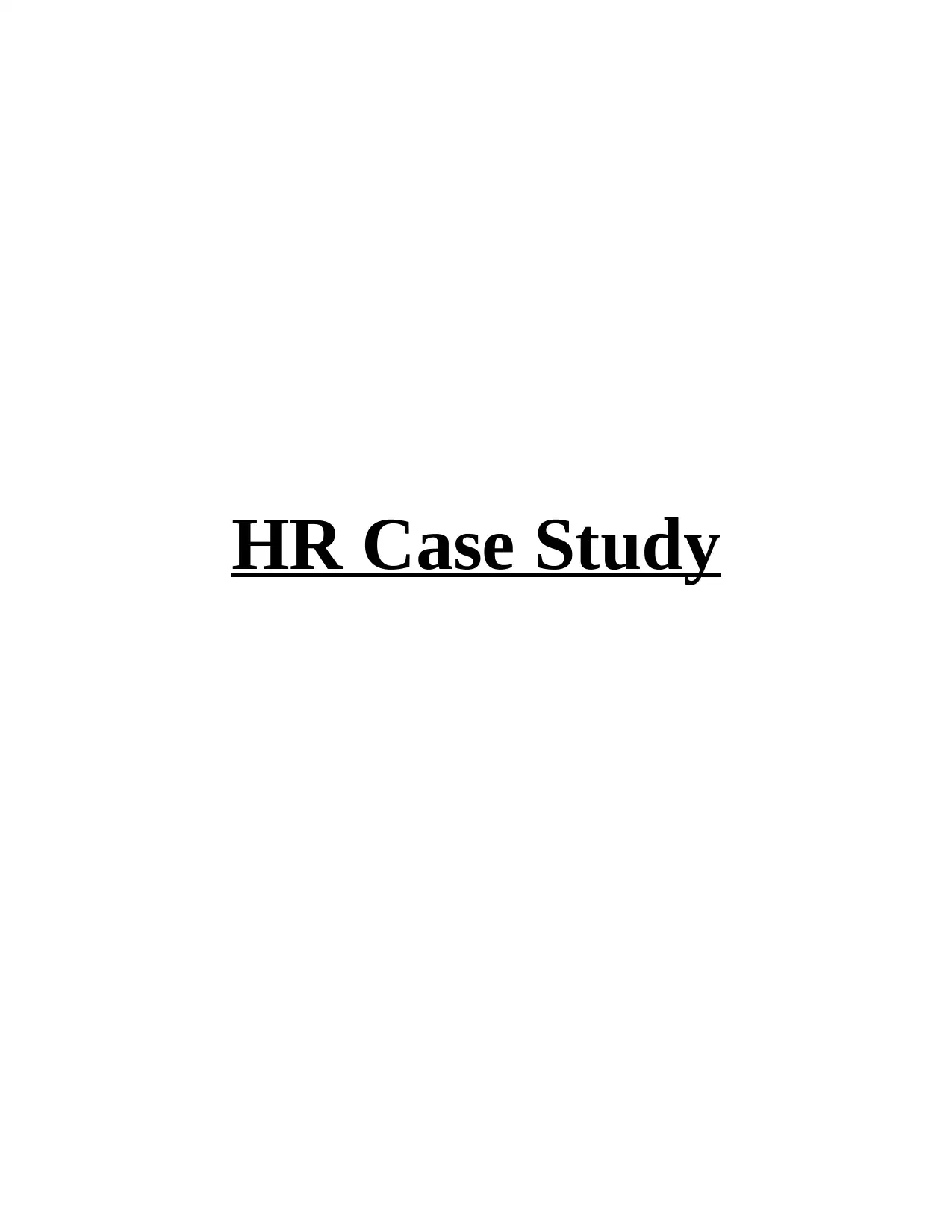
HR Case Study
Paraphrase This Document
Need a fresh take? Get an instant paraphrase of this document with our AI Paraphraser
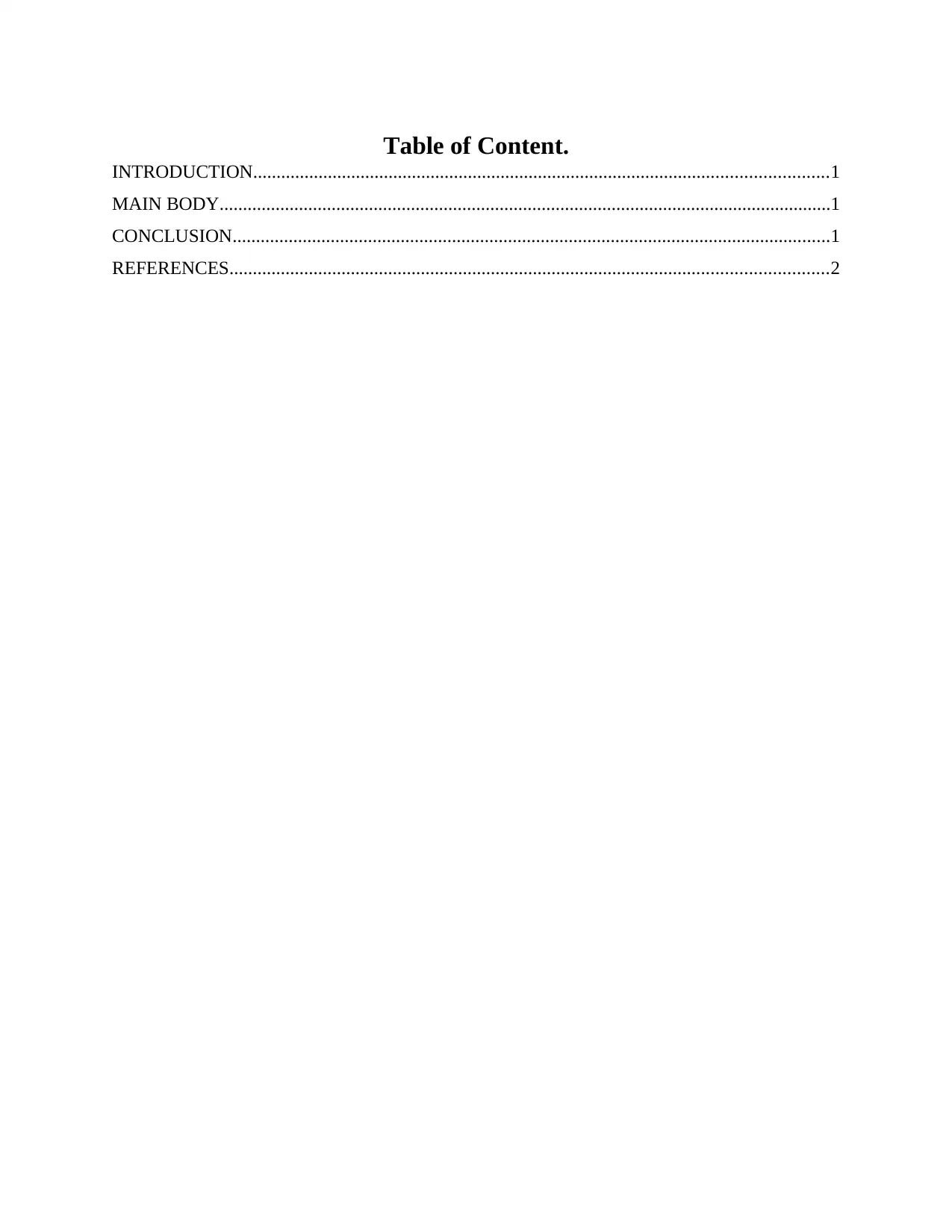
Table of Content.
INTRODUCTION...........................................................................................................................1
MAIN BODY...................................................................................................................................1
CONCLUSION................................................................................................................................1
REFERENCES................................................................................................................................2
INTRODUCTION...........................................................................................................................1
MAIN BODY...................................................................................................................................1
CONCLUSION................................................................................................................................1
REFERENCES................................................................................................................................2
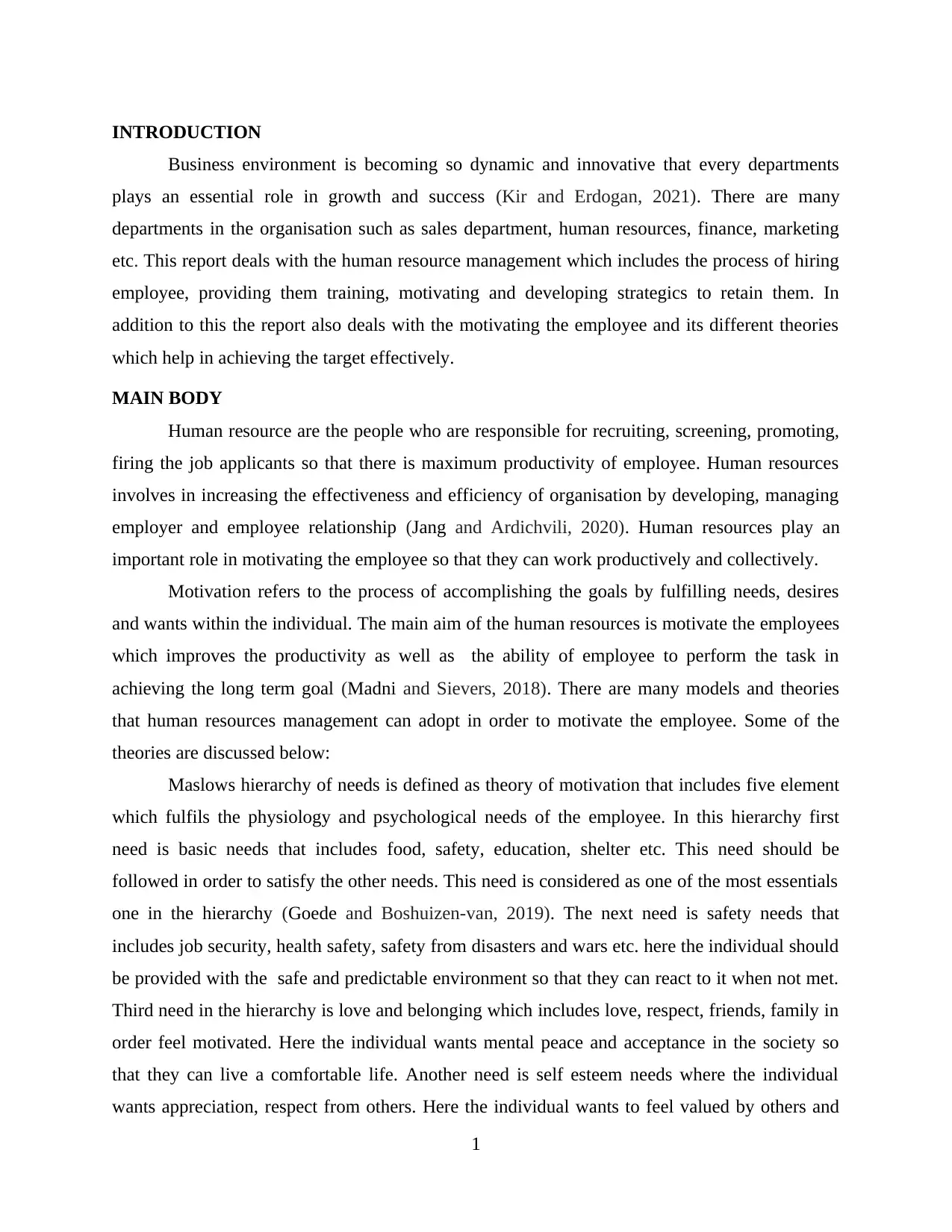
INTRODUCTION
Business environment is becoming so dynamic and innovative that every departments
plays an essential role in growth and success (Kir and Erdogan, 2021). There are many
departments in the organisation such as sales department, human resources, finance, marketing
etc. This report deals with the human resource management which includes the process of hiring
employee, providing them training, motivating and developing strategics to retain them. In
addition to this the report also deals with the motivating the employee and its different theories
which help in achieving the target effectively.
MAIN BODY
Human resource are the people who are responsible for recruiting, screening, promoting,
firing the job applicants so that there is maximum productivity of employee. Human resources
involves in increasing the effectiveness and efficiency of organisation by developing, managing
employer and employee relationship (Jang and Ardichvili, 2020). Human resources play an
important role in motivating the employee so that they can work productively and collectively.
Motivation refers to the process of accomplishing the goals by fulfilling needs, desires
and wants within the individual. The main aim of the human resources is motivate the employees
which improves the productivity as well as the ability of employee to perform the task in
achieving the long term goal (Madni and Sievers, 2018). There are many models and theories
that human resources management can adopt in order to motivate the employee. Some of the
theories are discussed below:
Maslows hierarchy of needs is defined as theory of motivation that includes five element
which fulfils the physiology and psychological needs of the employee. In this hierarchy first
need is basic needs that includes food, safety, education, shelter etc. This need should be
followed in order to satisfy the other needs. This need is considered as one of the most essentials
one in the hierarchy (Goede and Boshuizen-van, 2019). The next need is safety needs that
includes job security, health safety, safety from disasters and wars etc. here the individual should
be provided with the safe and predictable environment so that they can react to it when not met.
Third need in the hierarchy is love and belonging which includes love, respect, friends, family in
order feel motivated. Here the individual wants mental peace and acceptance in the society so
that they can live a comfortable life. Another need is self esteem needs where the individual
wants appreciation, respect from others. Here the individual wants to feel valued by others and
1
Business environment is becoming so dynamic and innovative that every departments
plays an essential role in growth and success (Kir and Erdogan, 2021). There are many
departments in the organisation such as sales department, human resources, finance, marketing
etc. This report deals with the human resource management which includes the process of hiring
employee, providing them training, motivating and developing strategics to retain them. In
addition to this the report also deals with the motivating the employee and its different theories
which help in achieving the target effectively.
MAIN BODY
Human resource are the people who are responsible for recruiting, screening, promoting,
firing the job applicants so that there is maximum productivity of employee. Human resources
involves in increasing the effectiveness and efficiency of organisation by developing, managing
employer and employee relationship (Jang and Ardichvili, 2020). Human resources play an
important role in motivating the employee so that they can work productively and collectively.
Motivation refers to the process of accomplishing the goals by fulfilling needs, desires
and wants within the individual. The main aim of the human resources is motivate the employees
which improves the productivity as well as the ability of employee to perform the task in
achieving the long term goal (Madni and Sievers, 2018). There are many models and theories
that human resources management can adopt in order to motivate the employee. Some of the
theories are discussed below:
Maslows hierarchy of needs is defined as theory of motivation that includes five element
which fulfils the physiology and psychological needs of the employee. In this hierarchy first
need is basic needs that includes food, safety, education, shelter etc. This need should be
followed in order to satisfy the other needs. This need is considered as one of the most essentials
one in the hierarchy (Goede and Boshuizen-van, 2019). The next need is safety needs that
includes job security, health safety, safety from disasters and wars etc. here the individual should
be provided with the safe and predictable environment so that they can react to it when not met.
Third need in the hierarchy is love and belonging which includes love, respect, friends, family in
order feel motivated. Here the individual wants mental peace and acceptance in the society so
that they can live a comfortable life. Another need is self esteem needs where the individual
wants appreciation, respect from others. Here the individual wants to feel valued by others and
1
⊘ This is a preview!⊘
Do you want full access?
Subscribe today to unlock all pages.

Trusted by 1+ million students worldwide
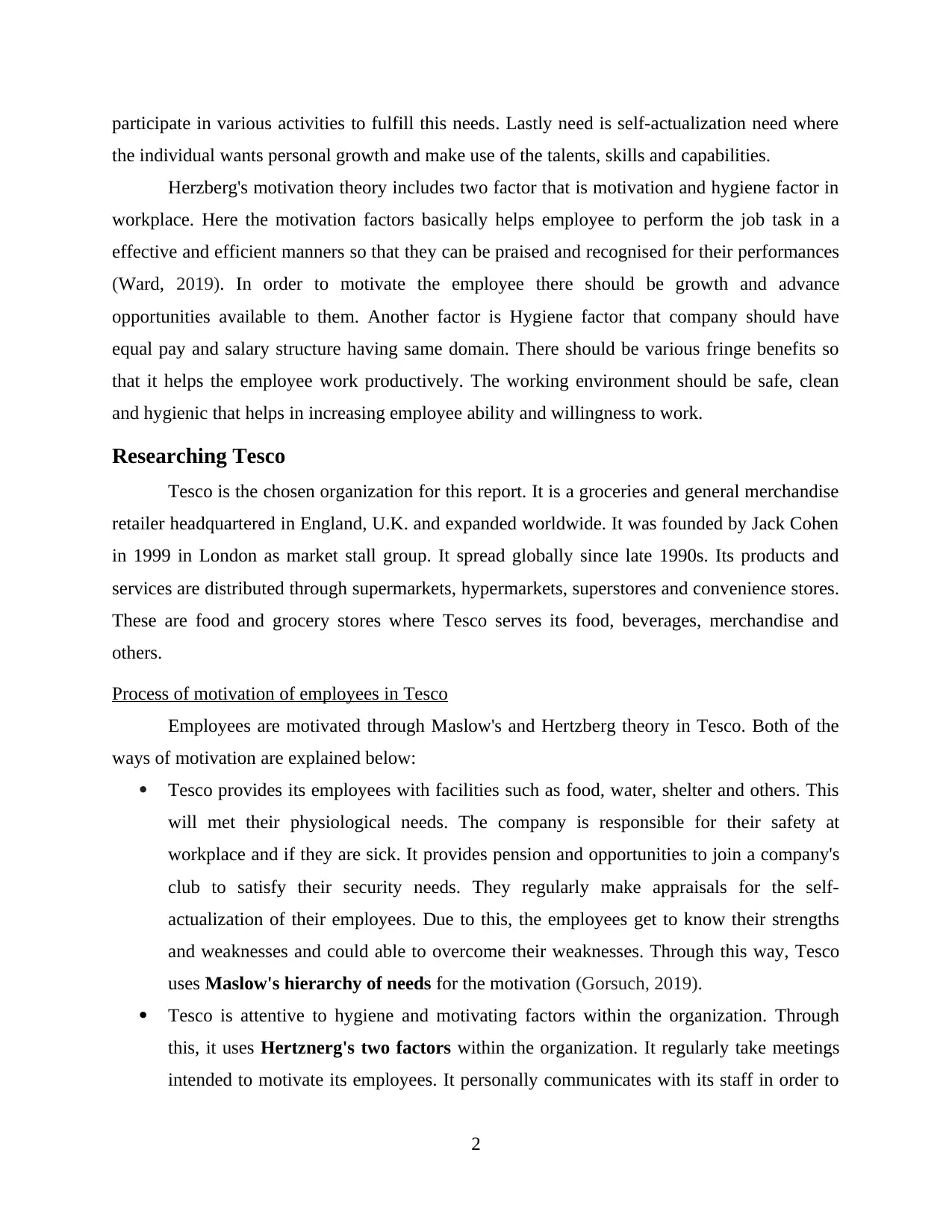
participate in various activities to fulfill this needs. Lastly need is self-actualization need where
the individual wants personal growth and make use of the talents, skills and capabilities.
Herzberg's motivation theory includes two factor that is motivation and hygiene factor in
workplace. Here the motivation factors basically helps employee to perform the job task in a
effective and efficient manners so that they can be praised and recognised for their performances
(Ward, 2019). In order to motivate the employee there should be growth and advance
opportunities available to them. Another factor is Hygiene factor that company should have
equal pay and salary structure having same domain. There should be various fringe benefits so
that it helps the employee work productively. The working environment should be safe, clean
and hygienic that helps in increasing employee ability and willingness to work.
Researching Tesco
Tesco is the chosen organization for this report. It is a groceries and general merchandise
retailer headquartered in England, U.K. and expanded worldwide. It was founded by Jack Cohen
in 1999 in London as market stall group. It spread globally since late 1990s. Its products and
services are distributed through supermarkets, hypermarkets, superstores and convenience stores.
These are food and grocery stores where Tesco serves its food, beverages, merchandise and
others.
Process of motivation of employees in Tesco
Employees are motivated through Maslow's and Hertzberg theory in Tesco. Both of the
ways of motivation are explained below:
Tesco provides its employees with facilities such as food, water, shelter and others. This
will met their physiological needs. The company is responsible for their safety at
workplace and if they are sick. It provides pension and opportunities to join a company's
club to satisfy their security needs. They regularly make appraisals for the self-
actualization of their employees. Due to this, the employees get to know their strengths
and weaknesses and could able to overcome their weaknesses. Through this way, Tesco
uses Maslow's hierarchy of needs for the motivation (Gorsuch, 2019).
Tesco is attentive to hygiene and motivating factors within the organization. Through
this, it uses Hertznerg's two factors within the organization. It regularly take meetings
intended to motivate its employees. It personally communicates with its staff in order to
2
the individual wants personal growth and make use of the talents, skills and capabilities.
Herzberg's motivation theory includes two factor that is motivation and hygiene factor in
workplace. Here the motivation factors basically helps employee to perform the job task in a
effective and efficient manners so that they can be praised and recognised for their performances
(Ward, 2019). In order to motivate the employee there should be growth and advance
opportunities available to them. Another factor is Hygiene factor that company should have
equal pay and salary structure having same domain. There should be various fringe benefits so
that it helps the employee work productively. The working environment should be safe, clean
and hygienic that helps in increasing employee ability and willingness to work.
Researching Tesco
Tesco is the chosen organization for this report. It is a groceries and general merchandise
retailer headquartered in England, U.K. and expanded worldwide. It was founded by Jack Cohen
in 1999 in London as market stall group. It spread globally since late 1990s. Its products and
services are distributed through supermarkets, hypermarkets, superstores and convenience stores.
These are food and grocery stores where Tesco serves its food, beverages, merchandise and
others.
Process of motivation of employees in Tesco
Employees are motivated through Maslow's and Hertzberg theory in Tesco. Both of the
ways of motivation are explained below:
Tesco provides its employees with facilities such as food, water, shelter and others. This
will met their physiological needs. The company is responsible for their safety at
workplace and if they are sick. It provides pension and opportunities to join a company's
club to satisfy their security needs. They regularly make appraisals for the self-
actualization of their employees. Due to this, the employees get to know their strengths
and weaknesses and could able to overcome their weaknesses. Through this way, Tesco
uses Maslow's hierarchy of needs for the motivation (Gorsuch, 2019).
Tesco is attentive to hygiene and motivating factors within the organization. Through
this, it uses Hertznerg's two factors within the organization. It regularly take meetings
intended to motivate its employees. It personally communicates with its staff in order to
2
Paraphrase This Document
Need a fresh take? Get an instant paraphrase of this document with our AI Paraphraser
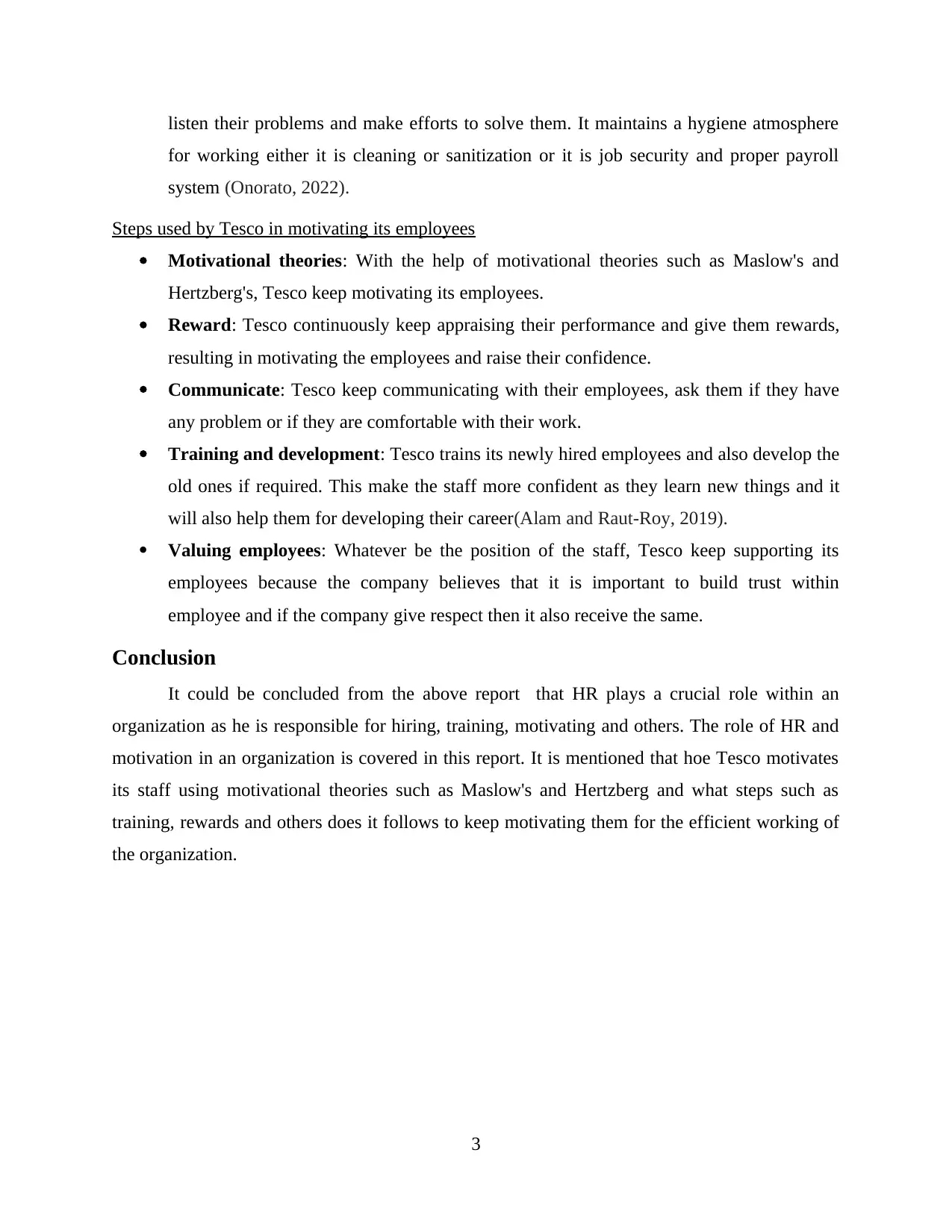
listen their problems and make efforts to solve them. It maintains a hygiene atmosphere
for working either it is cleaning or sanitization or it is job security and proper payroll
system (Onorato, 2022).
Steps used by Tesco in motivating its employees
Motivational theories: With the help of motivational theories such as Maslow's and
Hertzberg's, Tesco keep motivating its employees.
Reward: Tesco continuously keep appraising their performance and give them rewards,
resulting in motivating the employees and raise their confidence.
Communicate: Tesco keep communicating with their employees, ask them if they have
any problem or if they are comfortable with their work.
Training and development: Tesco trains its newly hired employees and also develop the
old ones if required. This make the staff more confident as they learn new things and it
will also help them for developing their career(Alam and Raut-Roy, 2019).
Valuing employees: Whatever be the position of the staff, Tesco keep supporting its
employees because the company believes that it is important to build trust within
employee and if the company give respect then it also receive the same.
Conclusion
It could be concluded from the above report that HR plays a crucial role within an
organization as he is responsible for hiring, training, motivating and others. The role of HR and
motivation in an organization is covered in this report. It is mentioned that hoe Tesco motivates
its staff using motivational theories such as Maslow's and Hertzberg and what steps such as
training, rewards and others does it follows to keep motivating them for the efficient working of
the organization.
3
for working either it is cleaning or sanitization or it is job security and proper payroll
system (Onorato, 2022).
Steps used by Tesco in motivating its employees
Motivational theories: With the help of motivational theories such as Maslow's and
Hertzberg's, Tesco keep motivating its employees.
Reward: Tesco continuously keep appraising their performance and give them rewards,
resulting in motivating the employees and raise their confidence.
Communicate: Tesco keep communicating with their employees, ask them if they have
any problem or if they are comfortable with their work.
Training and development: Tesco trains its newly hired employees and also develop the
old ones if required. This make the staff more confident as they learn new things and it
will also help them for developing their career(Alam and Raut-Roy, 2019).
Valuing employees: Whatever be the position of the staff, Tesco keep supporting its
employees because the company believes that it is important to build trust within
employee and if the company give respect then it also receive the same.
Conclusion
It could be concluded from the above report that HR plays a crucial role within an
organization as he is responsible for hiring, training, motivating and others. The role of HR and
motivation in an organization is covered in this report. It is mentioned that hoe Tesco motivates
its staff using motivational theories such as Maslow's and Hertzberg and what steps such as
training, rewards and others does it follows to keep motivating them for the efficient working of
the organization.
3
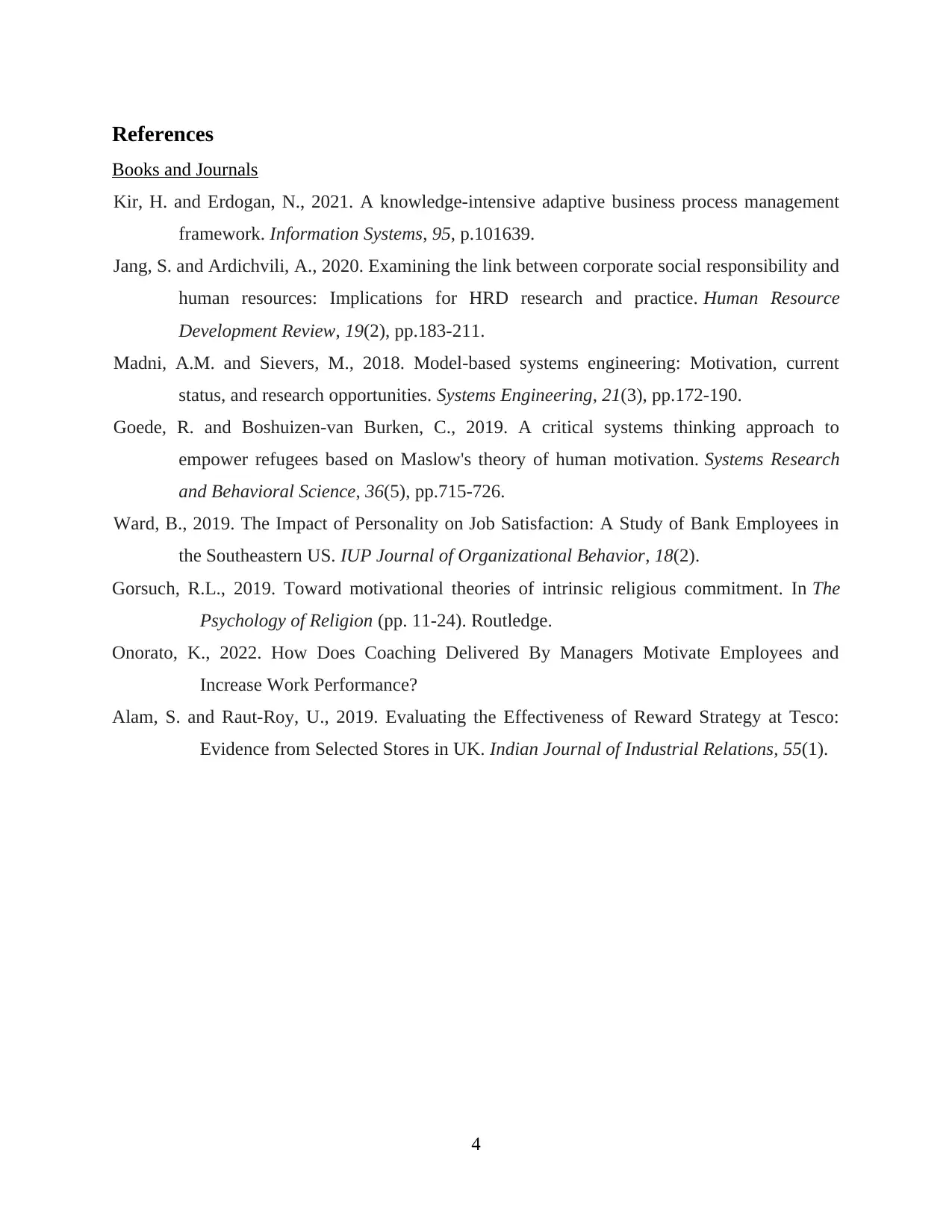
References
Books and Journals
Kir, H. and Erdogan, N., 2021. A knowledge-intensive adaptive business process management
framework. Information Systems, 95, p.101639.
Jang, S. and Ardichvili, A., 2020. Examining the link between corporate social responsibility and
human resources: Implications for HRD research and practice. Human Resource
Development Review, 19(2), pp.183-211.
Madni, A.M. and Sievers, M., 2018. Model‐based systems engineering: Motivation, current
status, and research opportunities. Systems Engineering, 21(3), pp.172-190.
Goede, R. and Boshuizen‐van Burken, C., 2019. A critical systems thinking approach to
empower refugees based on Maslow's theory of human motivation. Systems Research
and Behavioral Science, 36(5), pp.715-726.
Ward, B., 2019. The Impact of Personality on Job Satisfaction: A Study of Bank Employees in
the Southeastern US. IUP Journal of Organizational Behavior, 18(2).
Gorsuch, R.L., 2019. Toward motivational theories of intrinsic religious commitment. In The
Psychology of Religion (pp. 11-24). Routledge.
Onorato, K., 2022. How Does Coaching Delivered By Managers Motivate Employees and
Increase Work Performance?
Alam, S. and Raut-Roy, U., 2019. Evaluating the Effectiveness of Reward Strategy at Tesco:
Evidence from Selected Stores in UK. Indian Journal of Industrial Relations, 55(1).
4
Books and Journals
Kir, H. and Erdogan, N., 2021. A knowledge-intensive adaptive business process management
framework. Information Systems, 95, p.101639.
Jang, S. and Ardichvili, A., 2020. Examining the link between corporate social responsibility and
human resources: Implications for HRD research and practice. Human Resource
Development Review, 19(2), pp.183-211.
Madni, A.M. and Sievers, M., 2018. Model‐based systems engineering: Motivation, current
status, and research opportunities. Systems Engineering, 21(3), pp.172-190.
Goede, R. and Boshuizen‐van Burken, C., 2019. A critical systems thinking approach to
empower refugees based on Maslow's theory of human motivation. Systems Research
and Behavioral Science, 36(5), pp.715-726.
Ward, B., 2019. The Impact of Personality on Job Satisfaction: A Study of Bank Employees in
the Southeastern US. IUP Journal of Organizational Behavior, 18(2).
Gorsuch, R.L., 2019. Toward motivational theories of intrinsic religious commitment. In The
Psychology of Religion (pp. 11-24). Routledge.
Onorato, K., 2022. How Does Coaching Delivered By Managers Motivate Employees and
Increase Work Performance?
Alam, S. and Raut-Roy, U., 2019. Evaluating the Effectiveness of Reward Strategy at Tesco:
Evidence from Selected Stores in UK. Indian Journal of Industrial Relations, 55(1).
4
⊘ This is a preview!⊘
Do you want full access?
Subscribe today to unlock all pages.

Trusted by 1+ million students worldwide

5
1 out of 7
Related Documents
Your All-in-One AI-Powered Toolkit for Academic Success.
+13062052269
info@desklib.com
Available 24*7 on WhatsApp / Email
![[object Object]](/_next/static/media/star-bottom.7253800d.svg)
Unlock your academic potential
Copyright © 2020–2025 A2Z Services. All Rights Reserved. Developed and managed by ZUCOL.


